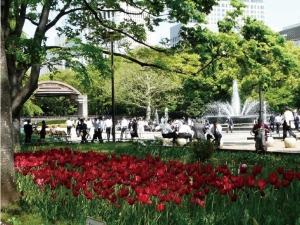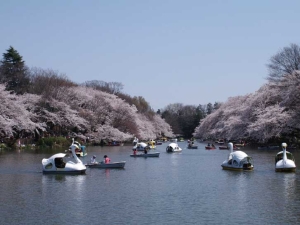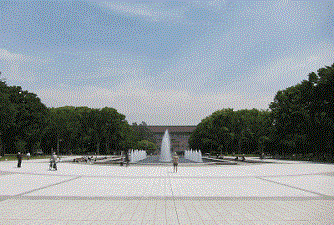Parks in Tokyo
Parks in Tokyo
The rich greenery, wide-open spaces, and open skies provided by parks make them invaluable places for recreation and add beauty to the
landscape.
In addition, the greenery of parks plays a role in cleaning the air, and the open spaces created serve as evacuation sites in times of disaster. Parks also help to ensure that outstanding natural scenery is preserved.
Parks are classified into three groups: “urban parks,” which are specifiedby the Urban Park Act; “parks other than urban parks,” which are deemed equivalent to urban parks; and “natural parks,” which are specified by the Natural Parks Act.
landscape.
In addition, the greenery of parks plays a role in cleaning the air, and the open spaces created serve as evacuation sites in times of disaster. Parks also help to ensure that outstanding natural scenery is preserved.
Parks are classified into three groups: “urban parks,” which are specifiedby the Urban Park Act; “parks other than urban parks,” which are deemed equivalent to urban parks; and “natural parks,” which are specified by the Natural Parks Act.
Data on Parks
As of April 1, 2020, the total area of urban parks and parks other than urban parks in Tokyo comes to 8,009 hectares, or 5.73 square meters per capita.
Of those parks, urban parks managed by the Bureau (metropolitan parks) are 82 locations totaling 2,030 hectares, including Ueno Park, Inokashira Park, gardens designated as cultural properties, zoos, and botanical gardens.
Of those parks, urban parks managed by the Bureau (metropolitan parks) are 82 locations totaling 2,030 hectares, including Ueno Park, Inokashira Park, gardens designated as cultural properties, zoos, and botanical gardens.
Urban parks 8,287 locations, 5,951 hectares
- National government parks (2 locations, 176 hectares)
- Metropolitan parks (82 locations, 2,030 hectares)
- Municipal parks (8,203 locations, 3,745 hectares)
Parks other than urban parks 3,695 locations, 2,058 hectares
- National gardens, etc. established by the national government
- Nature recreation parks established by the TMG Bureau of Environment
- Seaside parks established by the TMG Bureau of Port and Harbor
- Children's parks, etc. established by municipalities
- Parks established on residential sites by public housing corporations, etc.
Natural parks
- National Parks (3 locations, 69,426 hectares)
- Quasi-national parks (1 location, 777 hectares)
- Metropolitan natural parks (6 locations, 9,686 hectares)
※Data as of April 1, 2020
Development of Urban Parks
◆Policy
Along with making the TMG vision for greening set forth in the Action Plan for 2020 (formulated in December 2016), “creating and preserving a rich natural environment” a key initiative, the Bureau set a goal to develop 95hectares of new metropolitan parkland by 2020.
In addition to making steady progress with respect to expanding metropolitan parks, the Bureau is also working to realize the objectives outlined in the Action Plan for 2020 by advancing projects aimed at strengthening the functions of metropolitan parks key to disaster management, and recreating and restoring gardens designated as cultural properties to pass down historical and cultural heritages to the next generation.
In addition to making steady progress with respect to expanding metropolitan parks, the Bureau is also working to realize the objectives outlined in the Action Plan for 2020 by advancing projects aimed at strengthening the functions of metropolitan parks key to disaster management, and recreating and restoring gardens designated as cultural properties to pass down historical and cultural heritages to the next generation.
◆Project Status
In fiscal 2016, development of five parks, including Takiyama, Oto, and Nakato parks, was carried out. By opening an additional 6.4 hectares of new metropolitan parkland to the public on June 1, 2017, Tokyo’s park acreage open to the public increased to about 2,028 hectares. In fiscal 2017, theBureau steadily advanced the development of Takiyama, Oto, Nakato, and other parks, working toward further expansion of parkland.
Metropolitan parks have an important role in earthquake preparedness. In the TMG’s disaster management plan, some parks are designated as evacuation areas and/or bases for search and rescue operations. While developing new parks, the Bureau is also advancing work to make existing parks better prepared for a disaster, repair aging facilities, and retrofit buildings to enhance earthquake resistance.
In addition, metropolitan parks such as Yumenoshima Park will serve as both event and practice venues for the Olympic and Paralympic Games Tokyo 2020. As many visitors from around the world will attend, the Bureau is working toward the success of the Games by advancing the creation of multilingual signage and improvements to make park paths barrier-free at metropolitan parks designated as venues.
Metropolitan parks have an important role in earthquake preparedness. In the TMG’s disaster management plan, some parks are designated as evacuation areas and/or bases for search and rescue operations. While developing new parks, the Bureau is also advancing work to make existing parks better prepared for a disaster, repair aging facilities, and retrofit buildings to enhance earthquake resistance.
In addition, metropolitan parks such as Yumenoshima Park will serve as both event and practice venues for the Olympic and Paralympic Games Tokyo 2020. As many visitors from around the world will attend, the Bureau is working toward the success of the Games by advancing the creation of multilingual signage and improvements to make park paths barrier-free at metropolitan parks designated as venues.
Use of the Designated Administrator System
At metropolitan parks, cemeteries and other facilities managed by the Bureau, in order to meet the diverse needs of users, provide high-quality services, and ensure that administration and management is carried outeffectively and efficiently, the Bureau uses the designated administrator system which enables operations to be entrusted to approved private sector companies. The administration and management by the designated administrators are evaluated by a team including outside experts, and the results are released.
-
 Hibiya Park
Hibiya Park
-
 Inokashira Park
Inokashira Park

Ueno Park



